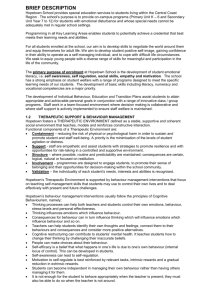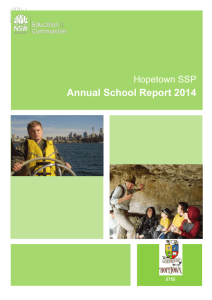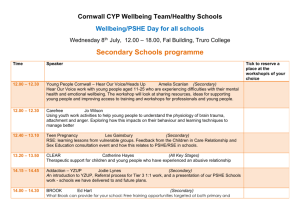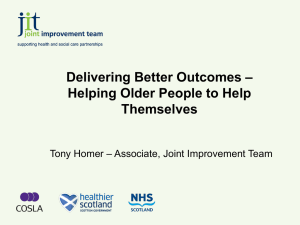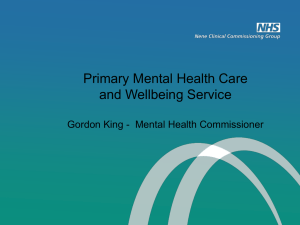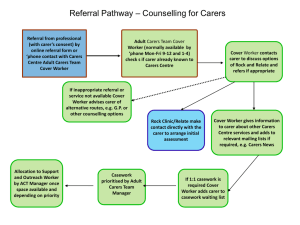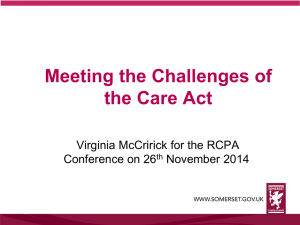School Plan 2015 - 2017 - HopeTown School
advertisement
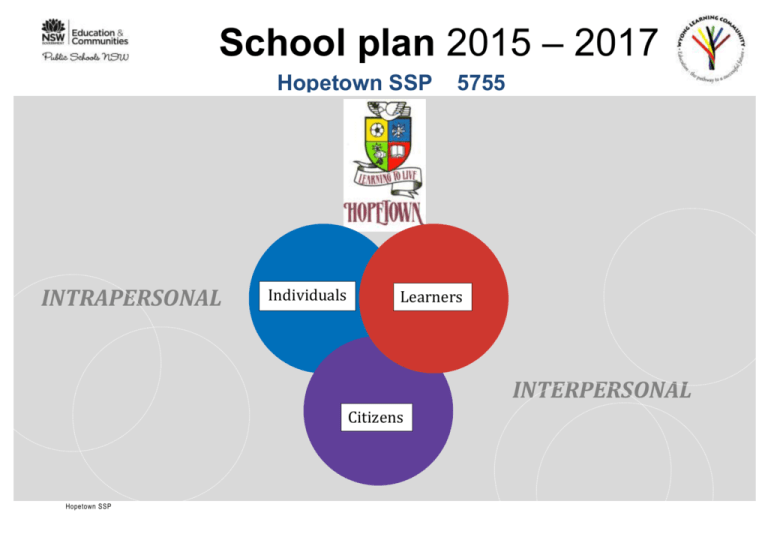
School plan 2015 – 2017 Hopetown SSP INTRAPERSONAL Individuals 5755 Learners INTERPERSONAL Citizens Hopetown SSP School background 2015 - 2017 School vision statement The collective purpose of the Hopetown School community is to ensure that every student becomes a successful learner, a confident and creative individual and an active, informed citizen.* Hopetown endeavours to provide every student the opportunity to experience success and to optimise their development of social, emotional, academic and vocational competencies. *The Melbourne Declaration on Educational Goals for Young Australians.. School context Hopetown is a School for Specific Purposes, supporting the needs of students (K-12) with Emotional Disturbance. Established in 1986, Hopetown has expansive grounds in a quiet, semi-rural environment bordered by bushland. All students have diagnoses of mental health disabilities, and are enrolled at Hopetown because of their difficulties in coping in a mainstream school setting. Most students have multiple diagnoses, present with challenging behaviours and are considered at risk of disengagement from learning. Accommodations and adjustments are made and reviewed as required. The maximum student population is 56 students. Twenty- one students are in the primary unit and 35 in the secondary unit. Classes are comprised of 7 students with a teacher and School Learning Support Officer. Approximately one third of the students are in out-of-home care and 20% of the school’s students are Aboriginal or Torres Strait Islander. The primary purpose of a student’s enrolment at Hopetown is to address the student’s social and emotional difficulties. The focus of the school’s Social and Emotional Learning (SEL) program is to develop Emotional Literacy dimensions of self-awareness, self-regulation, empathy, social skills and motivation. Within Hopetown’s SEL framework is the promotion of positive habits of mind and foundations of organisation, persistence, getting along, confidence and resilience. (cf. You Can Do It!) The ethos of the school is for all stakeholders to be Safe, Responsible and Respectful members of the school community. The school’s Family Occupation and Education Index (FOEI = 166) indicates significant socio-economic disadvantage within our school community. School attendance is encouraged and school suspensions are minimised in frequency and duration. Staff experience a high incidence of challenging student behaviours and the maintenance of positive staff morale is an ongoing concern. Significant staff training in behaviour support, crisis management and student and staff welfare are regular occurrences. Hopetown’s staff are collaborative, experienced, student-focused, empathic and committed to ongoing improvement in their practice. Hopetown’s programing documentation and delivery is school strength as are the Individual Education Plans and Personalised Learning Plans prepared for each student. Innovative programs have been a feature of Hopetown for many years. These include experiential programs for disengaged students, outdoor challenge programs, service learning, community access, the Duke of Edinburgh Award Scheme and an array of school camps. School planning process The school planning process was informed by school data including; student enrolment and attendance, student incident and welfare reports, student performance data from external and in-school assessments, student, staff and parent surveys, lesson observations, Teacher and Executive Assessment Review Schedule (TARS and EARS) discussions. Planning was undertaken in reference to the Public Schools NSW Strategic Directions- Creating Futures Together 2015–2017, the Public Schools NSW School Excellence Framework, the Disability Standards for Education 2005, National Disability Strategy 2010-2020, Student Diversity and the Australian Curriculum (ACARA), Australian Professional Standards for Teachers, Great Teaching Inspired Learning (GTIL), Local Schools Local Decisions (LSLD), Every Student Every School (ESES), Rural and Remote Education, Quality Teaching in NSW Schools, The Melbourne Declaration on Educational Goals for Young Australians, Aboriginal and Torres Strait Islander Action Plan 2010–2014, Aboriginal Human Resources Development Plan 2012- 2017. It was decided that a situational analysis ‘snapshot’ of 2014 was useful however it needed to be further qualified by examining data from recent years in order to detect any trends. Some of the data sources were: Tell them from Me surveys Quality of School Life parent/carer survey (modified) Emotional Literacy Assessment (Southampton Psychology Service) parent, teacher and student questionnaires SENTRAL student welfare referral data NAPLAN results Hopetown SSP Transition Planning Meeting and Personalised Learning Plan parent /carer interview responses Staff program registrations Student exit patterns Clinicians’ reports and diagnostic data Student performance and diagnostic assessments and placement tests e.g. WRAT-4, Neale Analysis of Reading School strategic directions 2015 - 2017 Promoting positive lifelong development of the individual, the learner and the citizen. STRATEGIC DIRECTION 1 Empathic, resilient, motivated individuals. STRATEGIC DIRECTION 2 STRATEGIC DIRECTION 3 Students and staff are leaders of their learning A community of socially responsible citizens Purpose: Purpose: Purpose: To nurture students as motivated individuals valuing self and demonstrating self-efficacy, resilience and internal control. To develop a dynamic learning environment that empowers individuals to be flexible, adaptive, discerning learners and leaders. To encourage awareness of the individual as part of a wider society and create a culture of reciprocal and active concern for the wellbeing of others. Hopetown SSP Strategic Direction 1: Empathic, resilient, motivated individuals. Purpose People Processes Students: Students understand the need to trust and accept support offered. Students accept the need and responsibility for their intrapersonal development. Purpose: To nurture students as motivated individuals valuing self and demonstrating self-efficacy, resilience and internal control. Staff: Staff promote a therapeutic environment focussed on student welfare. Staff empathy is enriched and informed by research and staff practices are collaborative and evidence-based. Improvement Measures Decrease in negative referrals on SENTRAL Students will reflect ongoing development of Emotional Literacy Dimensions. Student capacities for sustained focussed attention, self-awareness and self-regulation will be assessed and reflect growth. Individualised assessment (PLASST) and monitoring of student progress from needs to strengths in learning and personal capabilities will reflect progression in each of the 6 domains. Hopetown SSP Parents/Carers: Parents/Carers engage positively with the school community, understand the important roles they play in a student’s social and emotional development and reflect the school’s expectations. Community Partners: External agencies, clinicians and other partners sustain support for students and constructive collaboration with the school. Clinical support for Hopetown’s students will be extended in availability and frequency. Leaders: Leaders promote a culture of therapeutic student support, professional effectiveness of all school members and continual improvement. Take positive steps to provide a safe environment focussed on the wellbeing of both staff and students. Staff will be trained in the delivery of mindfulness-based exercises designed to increase capacities for focussed attention, emotional regulation, self-reflection, resilience and other intrapersonal strengths. All staff are trained in Trauma Informed Practice in Schools, conflict resolution, crisis and behaviour management, elements of Positive Psychology Identify and implement the use of an assessment tool to develop comprehensive diagnostic profiles of social and emotional states. Develop mechanisms to improve the quality, frequency and efficacy of counsellor and clinical support for all students. Professional Learning for staff in Positive Partnerships to enhance support for parents and students. Evaluation Plan This school plan will be measured against the milestones and monitored by executive and whole-school staff, e.g. SENTRAL referral data, every 5 weeks by executive, every term by staff. Emotional Literacy data, Term 1 and Term 4 by all homeroom teachers. PLASST profiles, Term 1 and Term 4 by homeroom teachers. Products and Practices Products: Increased student engagement and selfregulation evidenced by the number of weekly negative referrals decreasing by 10% each term. 80% of students will show an annual increase of at least one Score Band in each domain of their Emotional Literacy Assessment. Student capacities for sustained focussed attention, self-awareness and emotional regulation will be assessed and quantified against a worldwide recognised assessment tool. 100% of students will have profiles from the new DEC Personalised Learning and Support Signposting Tool (PLASST) to help the school gauge and monitor student personal and learning strengths and needs. Practices: All staff model and reinforce school expectations of safety, respect and responsibility in all aspects of school life. Counsellor and clinical support is recognised as essential to student development Every student and staff member will practice Mindfulness activities daily to raise awareness of thoughts, feelings and actions. Strategic Direction 2: Students and staff are leaders of their learning. Purpose People Processes Products and Practices To develop a dynamic learning environment that empowers individuals to be flexible, adaptive, discerning learners and leaders. Students: See learning as a personal responsibility and essential for transformation. Develop the courage and resilience to view learning as a challenge and not a threat. Products: Staff: Recognise the importance of ensuring that student and staff wellbeing is prioritised and that the school’s expectations of safety, respect and responsibility are embedded in all aspects school culture. Parents/Carers: Support the school by sharing high expectations, participating positively in student-centred meetings (e.g. IEP, PLP, ITP) and maintaining close communication with the school. Improvement Measures Staff are actively engaged in their Performance and Development Framework. Increasing involvement of parent/carer signoff on IEP, PLP and ITP planning meeting records. Ongoing monitoring and plotting of students on the new literacy and numeracy continuum (PLAN or SENTRAL) will reflect student progress. Staff actively engage with and collaborate with the AECG and AEO. Community Partners: External agencies, members of the Aboriginal community (e.g. AECG) will engage and work in partnership to improve student outcomes. Leaders: Will monitor and promote staff and student wellbeing. Will build the capacity for all staff to achieve progress in their profession and career advancement. Will ensure the maintenance of a staff focus on student outcomes. Staff professional learning in all new syllabus documents, differentiated programing and delivery, the Quality Teaching Framework, the Pirozzo matrix, scaffolding practices and embedding technology into quality teaching to support student learning needs. Selected staff and executive will be trained in Stronger Smarter and 8 Ways Aboriginal Pedagogy and pass on training to staff. 100% of staff will develop a Professional Development Plan (PDP) and provide evidence of progress towards identified goals. 90% of parents/carers will attend IEP, PLP and ITP meetings by the end of each year. 100% of students will be plotted and on the new literacy and numeracy continuum (PLAN) Teaching staff are provided with professional learning in DEC and NSW educational reforms under LSLD. 80% of students will achieve measurable gains along each continuum when monitored every term. Executive and selected staff are trained in mentoring and coaching aspirants. Staff attendance at 100% AECG meetings and feedback to school staff meetings. Evaluation Plan Ongoing review and evaluation of targeted programs that have been implemented to increase student outcomes. This school plan will be measured against the milestones and monitored by executive every five weeks and by the whole staff every term. Closely monitor school-based assessment data and NAPLAN results to analyse student performance. Hopetown SSP Practices: Staff will consider relevant DEC reforms in the process of setting personal learning and leadership goals. Staff employ the Quality Teaching Framework with particular emphasis on dimensions of Significance and Quality Learning Environment. Staff have increased awareness of and ability to meet learning and social/emotional needs of Aboriginal students. Students, staff and carers actively participate in the development of IEP, PLP, and ITP. Strategic Direction 3: A community of socially responsible citizens. Purpose People Processes To encourage awareness of the individual as part of a wider society and create a culture of reciprocal and active concern for the wellbeing of others. Students: Need to have a vision beyond selfinterest and to see meaning in being a positive, contributing part of the school and many other communities be they local, international or cyber. A review will be conducted to determine threats to student and staff welfare at Hopetown. Review recommendations will determine relevant school processes. Staff: Ensure students feel they belong and are valued at Hopetown, that they can experience success and that their success will be acknowledged and celebrated. Staff will participate in professional networks. Principal and executive will maintain active involvement in the Wyong Learning Community (LMG). Parents/Carers: Feel they are listened to at Hopetown. Broaden their goals for post school outcomes. Encourage student service learning and student contributions to the school and broader community. Inclusion of Service Learning in the stage 5 and 6 curriculum. The provision of professional learning for staff in the new DEC wellbeing framework. Community Partners: Endorse and facilitate positive student involvement in the community. Maintain consistent links with the Hopetown school community. A review of school suspension options. The implementation of a program to prepare students for successful participation in major off campus activities. This will include explicit teaching of teamwork, cooperative games and activities and group leadership principles. Improvement Measures Survey data will show an increase in the number of parents/carers responding to Hopetown’s annual school culture, parent/carer satisfaction survey. Responses to the above survey will be ‘Always’ or ‘Usually’ indicating strong community satisfaction levels. Increasing numbers of Stage 6 students will be participating in Hopetown’s Work Experience Program and enrolled in a TVET course each year. Increasing numbers of leaving students will be successfully linked to a post-school support agency, training organisation or employer at the time of leaving Hopetown. Return-from-suspension meeting minutes will evidence a school commitment to student and staff welfare. Increased attendance data reflects student sense of belonging. Hopetown SSP Leaders: Model dynamism and a commitment to the school vision. Ensure Hopetown has a culture of collaborative learning, social responsibility and mutual concern for wellbeing. Ensure that the school will be as therapeutic a learning environment as possible with available resources. Will prioritise staff and student wellbeing. Products and Practices Products: Evaluation Plan This school plan will be measured against the milestones and monitored by executive and wholeschool staff. An annual survey of school culture and parent/carer satisfaction consistent in format with previous years in order to determine any trends. Annual Tell Them From Me Teacher, Parent and Student online surveys. SENTRAL referral data will be used to determine improvements in post-suspension student behaviours. This will be done to evaluate alternative suspension initiatives and responses. To be monitored by executive every five weeks. 90% parents/carers respond to Hopetown’s annual school culture, parent/carer satisfaction survey with100% of responses to the above survey including ‘Always’ or ‘Usually’ indicating strong community satisfaction levels. 100% of return-from-suspension meeting minutes will evidence a school commitment to student and staff welfare. Attendance data indicates an increase from 89% to 92% as an indication of a safe learning environment and student connection. Practices: Service learning will be embedded in stages 5 and 6. This is intended to reinforce a student’s sense of civic responsibility and communal connectedness. The school curriculum provides cooperative learning opportunities to prepare students for successful participation in major off and community campus activities. Teachers and executive work together on Wyong Learning Community initiatives to build and share professional expertise. Hopetown staff will provide training to visiting colleagues and to other educational settings in the broader school community to develop the capacity of colleagues. All school communications will support a cohesive, inclusive and well-informed school community. Aboriginal parents and students feel welcome, valued and integral to the school community.
